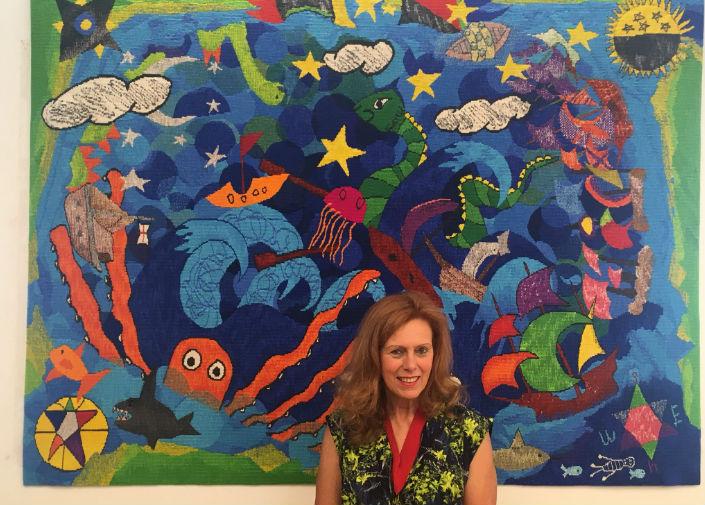Philip Sanderson, Studio Leader, at West Dean Tapestry Studio tells the story of a unique tapestry that has been created for our Learning Centre with a design conceived by the children of St John the Evangelist School in Angel, Islington.
In 2017, West Dean Tapestry Studio was commissioned to make a tapestry for the education room at the Charterhouse kindly funded by the former Sheriff of the City of London, Neil Redcliffe. The children of year 5 Neptune class at St John The Evangelist School, Angel were invited to develop ideas and artwork for this special piece of work – and we had two creative sessions with them.
The theme of the tapestry was shipwrecks and the sea, inspired by one of the very first brothers to live at the Charterhouse, Captain George Fenner who was a ship owner and sailor. For the creative sessions my colleague Ellie Rudd and I went to St John’s with examples of old nautical maps that included some wonderful illustrations of sea monsters. We also took images of the sea, weather and navigation (compasses etc.) and talked to the class about tapestry as a storytelling medium and to illustrate this, showed examples of tapestries that depicted stories from history. We talked about famous shipwrecks and the Mary Rose was mentioned – it turned out some of the children had seen the Mary Rose in Portsmouth and that visit inspired some of the imagery in the final tapestry design.

Sue Illman
The children produced a large array of drawings and collages; all different kinds of ships and sea creatures, lighthouses and flags, moons, stars and waves. The best drawings were selected, (it was important that each of the thirty children ion the class had one drawing included in the design) scanned and arranged into a design that could be translated into tapestry. The children were also able to try their hand at tapestry weaving working on small pieces of weaving supervised by Ellie.
Once the final design was established the process of weaving could begin with a number of processes taking place simultaneously; the design is transformed into a cartoon, a kind of map the drawing that sits behind the warps and guides the weavers, the palette of yarns is dyed and the warp is installed onto the loom. The process of weaving begins with a selvedge that includes the studio mark, the weavers mark and the year the tapestry will be completed. The tapestry took six months to complete and was installed on July 12th in the education room at the Charterhouse with a lovely unveiling ceremony attended by the children, Sue Illman, Master of the Worshipful Company of Paviors and Liz Green, the new Sheriff of the City of London.
Philip Sanderson trained at Middlesex Polytechnic and the Royal College of Art, and Trainee Weaver Ellie Rudd studied at Chichester University. Since 1976, West Dean’s Tapestry Studio has worked with contemporary artists and designers to translate their images into woven tapestry. Since weaving 23 tapestries for The Henry Moore Foundation, the Studio also went on to work with artists John Piper, Howard Hodgkin, Eileen Agar, Matty Grunberg, Philip Sutton, Bill Jacklin, Adrian Berg.
The studio has extensive experience of heritage tapestry projects, including The Hunt of the Unicorn, a series of seven tapestries based on 15th century originals commissioned by Historic Scotland. It was the biggest weaving project undertaken in the UK for 100 years, involved 18 international weavers and took 13 years to complete in 2015.

